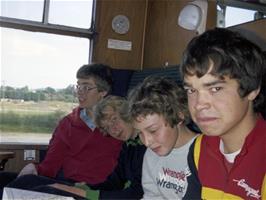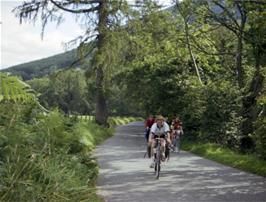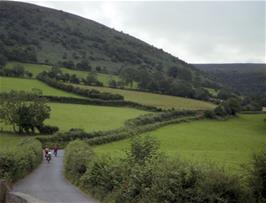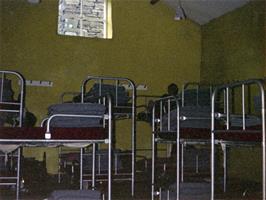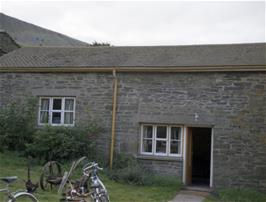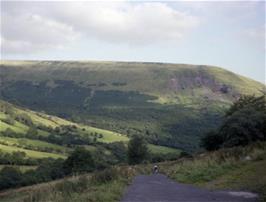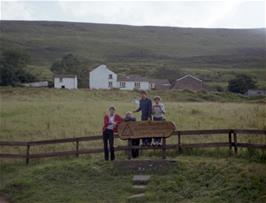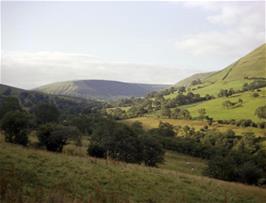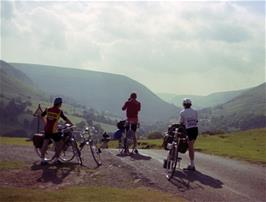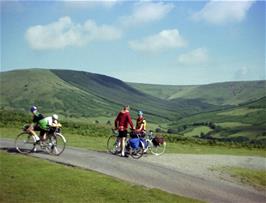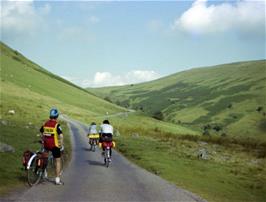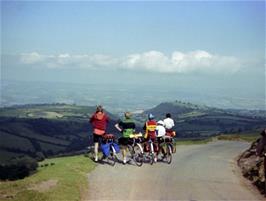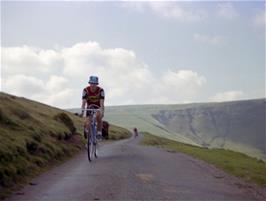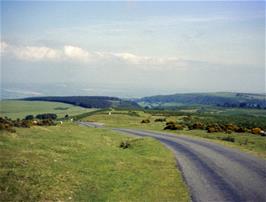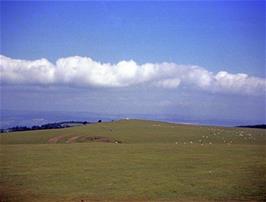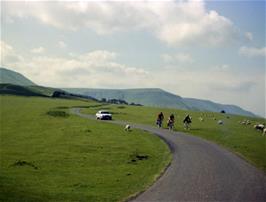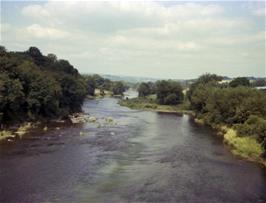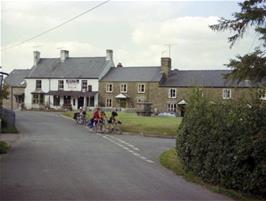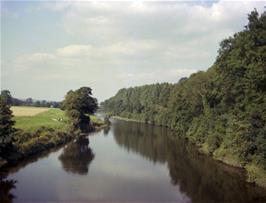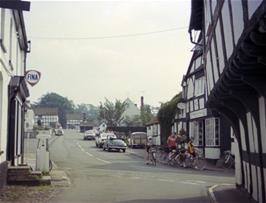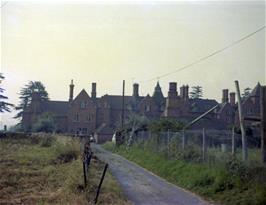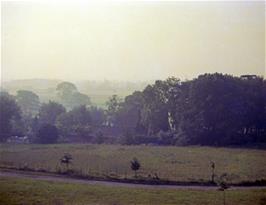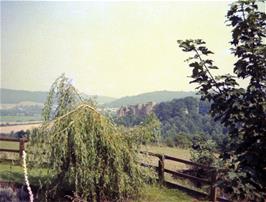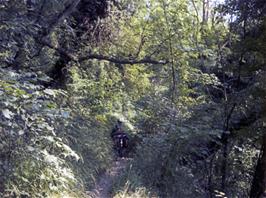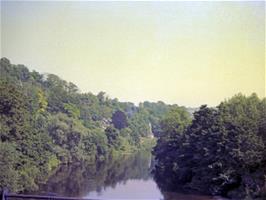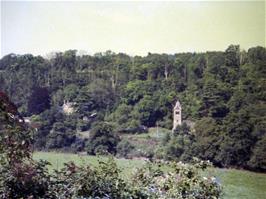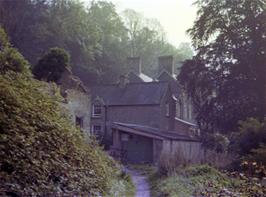Torbay CTC Album
Reports
Page 1 of 1 (5 items)
Saturday 23 August 1980
07:00 - 23:00
07:00 - 23:00
Tour: South Wales
Day 1: Home to Capel-y-Ffin YH
Day 1: Home to Capel-y-Ffin YH
Sunny and warm
15 miles
15 miles
5 Participants:
Colin Downie, Antony House, Carl Jefferys, Michael Jones, Philip Wrigley
Some of the younger Torbay members thought it would be a good idea to organise our own tour this year, keeping distances down to around 35 miles per day. Five of us got together at Christmas last year to plan the holiday and the following account relates the result.
At the crack of dawn on Saturday 23rd August something stirred in the heart of the Dart Valley. Unknown to the sleeping locals an incredible event was occurring – three Dartmoor CTC members were on the road before the arrival of their daily “pinta”! They were in fact Colin Downie, Antony House and myself, making our way to Newton Abbot Station to meet our two Torbay companions, Carl Jeffereys and Philip Wrigley.
After showing numerous railcards we were given our tickets and, after tackling stairs, arrived at the platform in good time to catch the 0857 train to Bristol. The train journey was made doubly enjoyable by the good weather – unbelievable after the rains of the previous week – and everyone was in high spirits. Our two changes at Bristol and Newport were effected without difficulty and soon we were speeding through the beautiful scenery of South Wales to our destination – Abergavenny station.
After picking up a few provisions in the town we made our way through Mardy to the lanes and found a quiet lunch spot near Llwyn-gwyn. It wasn’t long before the kettle was boiling and an enjoyable hour was spent lapping up the scenery and the coffee.
There was a great similarity between the lanes of this area and the country lanes of South Devon, but the scenery became quite different as we approached the Black Mountains. Our road wound its way up the Afon Honddu valley and soon the massive hills appeared to enclose us on all sides. Passing through Llanthony we noticed an ancient priory in an isolated spot on the mountainside, built there in the 11th Century because of the peace and tranquillity of the valley. The priory has since become derelict and a pony-trekking centre now attracts many people to the area during the summer, but little else has changed to affect the sanctity that William de Lacy experienced all those years ago.
Capel-y-Ffin is a tiny hamlet deep in the mountains, consisting of a pub and a telephone box, and about one mile further along the lane we found the hostel. It was one of the most attractive hostels we had ever visited, situated a little way up the side of a desolate hill, and the views were well worth the long climb from Abergavenny. There was no sign of human habitation anywhere else in the valley, but there were many white dots scattered around to show us that at least sheep could survive high up on the mountains.
After a superb meal we climbed up behind the hostel to take in some of the grandeur of the scenery. On the spur of the moment I decided to continue to the top and scrambled up the almost vertical hillside for more than fifteen minutes before reaching my target. It was almost dark, but even so I could see the heather stretching along the ridge into the distance. Looking back the way I had come it was just possible to make out the hostel and the twisty road at the bottom. On the other side of the ridge was a new valley, just as beautiful as ours but without the mark of man. The paradise was fading fast with the light and suddenly I felt along up there with no-one but the sheep. Within three minutes I had descended six hundred feet to re-join the others and, after a few pints of milk, we were ready for bed.
(Michael Jones)
At the crack of dawn on Saturday 23rd August something stirred in the heart of the Dart Valley. Unknown to the sleeping locals an incredible event was occurring – three Dartmoor CTC members were on the road before the arrival of their daily “pinta”! They were in fact Colin Downie, Antony House and myself, making our way to Newton Abbot Station to meet our two Torbay companions, Carl Jeffereys and Philip Wrigley.
After showing numerous railcards we were given our tickets and, after tackling stairs, arrived at the platform in good time to catch the 0857 train to Bristol. The train journey was made doubly enjoyable by the good weather – unbelievable after the rains of the previous week – and everyone was in high spirits. Our two changes at Bristol and Newport were effected without difficulty and soon we were speeding through the beautiful scenery of South Wales to our destination – Abergavenny station.
After picking up a few provisions in the town we made our way through Mardy to the lanes and found a quiet lunch spot near Llwyn-gwyn. It wasn’t long before the kettle was boiling and an enjoyable hour was spent lapping up the scenery and the coffee.
There was a great similarity between the lanes of this area and the country lanes of South Devon, but the scenery became quite different as we approached the Black Mountains. Our road wound its way up the Afon Honddu valley and soon the massive hills appeared to enclose us on all sides. Passing through Llanthony we noticed an ancient priory in an isolated spot on the mountainside, built there in the 11th Century because of the peace and tranquillity of the valley. The priory has since become derelict and a pony-trekking centre now attracts many people to the area during the summer, but little else has changed to affect the sanctity that William de Lacy experienced all those years ago.
Capel-y-Ffin is a tiny hamlet deep in the mountains, consisting of a pub and a telephone box, and about one mile further along the lane we found the hostel. It was one of the most attractive hostels we had ever visited, situated a little way up the side of a desolate hill, and the views were well worth the long climb from Abergavenny. There was no sign of human habitation anywhere else in the valley, but there were many white dots scattered around to show us that at least sheep could survive high up on the mountains.
After a superb meal we climbed up behind the hostel to take in some of the grandeur of the scenery. On the spur of the moment I decided to continue to the top and scrambled up the almost vertical hillside for more than fifteen minutes before reaching my target. It was almost dark, but even so I could see the heather stretching along the ridge into the distance. Looking back the way I had come it was just possible to make out the hostel and the twisty road at the bottom. On the other side of the ridge was a new valley, just as beautiful as ours but without the mark of man. The paradise was fading fast with the light and suddenly I felt along up there with no-one but the sheep. Within three minutes I had descended six hundred feet to re-join the others and, after a few pints of milk, we were ready for bed.
(Michael Jones)
Sunday 24 August 1980
08:00 - 23:00
08:00 - 23:00
Tour: South Wales
Day 2: Capel-y-Ffin to Staunton-on-Wye YH
Day 2: Capel-y-Ffin to Staunton-on-Wye YH
5 Participants:
Colin Downie, Antony House, Carl Jefferys, Michael Jones, Philip Wrigley
Next morning we were greeted by the sun again, and after chatting with a few of our fellow hostellers and mending Carl’s puncture, we finally got on the road by 10:30. A steep climb took us over the top of the mountains through Gospel Pass and all of us were breath taken by the splendid view. We dropped down the other side in stages, taking numerous pictures on the way, but we knew that photographs could not do real justice to what we were experiencing.
We attempted to pick up the path along the Offa’s Dyke – a massive fortification built around AD 770 along the English border – but unfortunately there was a steep drop which wasn’t really suited to heavily-laden cycles, so we stopped for lunch in the shade of some apple trees before climbing back to the road.
Hay-on-Wye was an interesting old town, if only because every other shop sold second-hand books! The castle told a story of its own, but the rough days of the past have long since disappeared to leave a peaceful town in which the centre of attraction is the sale of Clun and Kerry sheep at the market. In the main square we met one of our friends from Capel-y-Ffin who had hit a stone on the way down and irreparably damaged his front inner tube. One of my spares was soon on the rim and then Phil and I helped straighten his wheel – “Everybody’s Gotta Learn Sometime” as the Korgis song goes. After a few refreshments we ambled down to the bridge where we watched a canoe club paddling downstream. It was a lazy afternoon and we could have stayed there all day, but time was pressing.
Following the B4348 for a few miles brought us to the quaint little village of Dorstone, which rewarded us with a couple of photographs. From there we took the lanes over Dostone Hill to Bredwardine. Here again was the Wye and a spot by the riverside had attracted a flock of people for an afternoon’s bathing.
After an interesting chat with a local lad on the bridge we proceeded to Staunton-on-Wye to find our second hostel. Shortly after our arrival we met old friends again – a boys club from Bristol who had stayed at Capel-y-Ffin the previous night. This time we had a dormitory to ourselves and after a few hours some of us discovered that the “UFO” on the horizon was in fact a radar dish at Thruxton – life is fun isn’t it! After planning our route for the next day we turned in with happy dreams. What new adventures would the coming days bring?
(Michael Jones)
We attempted to pick up the path along the Offa’s Dyke – a massive fortification built around AD 770 along the English border – but unfortunately there was a steep drop which wasn’t really suited to heavily-laden cycles, so we stopped for lunch in the shade of some apple trees before climbing back to the road.
Hay-on-Wye was an interesting old town, if only because every other shop sold second-hand books! The castle told a story of its own, but the rough days of the past have long since disappeared to leave a peaceful town in which the centre of attraction is the sale of Clun and Kerry sheep at the market. In the main square we met one of our friends from Capel-y-Ffin who had hit a stone on the way down and irreparably damaged his front inner tube. One of my spares was soon on the rim and then Phil and I helped straighten his wheel – “Everybody’s Gotta Learn Sometime” as the Korgis song goes. After a few refreshments we ambled down to the bridge where we watched a canoe club paddling downstream. It was a lazy afternoon and we could have stayed there all day, but time was pressing.
Following the B4348 for a few miles brought us to the quaint little village of Dorstone, which rewarded us with a couple of photographs. From there we took the lanes over Dostone Hill to Bredwardine. Here again was the Wye and a spot by the riverside had attracted a flock of people for an afternoon’s bathing.
After an interesting chat with a local lad on the bridge we proceeded to Staunton-on-Wye to find our second hostel. Shortly after our arrival we met old friends again – a boys club from Bristol who had stayed at Capel-y-Ffin the previous night. This time we had a dormitory to ourselves and after a few hours some of us discovered that the “UFO” on the horizon was in fact a radar dish at Thruxton – life is fun isn’t it! After planning our route for the next day we turned in with happy dreams. What new adventures would the coming days bring?
(Michael Jones)
Monday 25 August 1980
08:00 - 23:00
08:00 - 23:00
Tour: South Wales
Day 3: Staunton-on-Wye Area Tour
Day 3: Staunton-on-Wye Area Tour
5 Participants:
Colin Downie, Antony House, Carl Jefferys, Michael Jones, Philip Wrigley
To our disappointment there appeared to be no riverside spots suitably public for a brew-up. In time, thoughts of coffee were surpassed by a desire for something a little more satisfying, but just when all hopes of dinner seemed lost we stumbled across a friendly Inn at Tillington which supplied us with all the necessary victuals.
The afternoon brought yet higher temperatures and, as none of us felt too energetic, we contented ourselves with traversing the six miles to Weobley before tea. At this juncture we made a disastrous mistake. Seeing a long, shady hedge inside a soft, grassy field, we did what any other cyclist would have done in such weather – transported everything over the gate and laid out out tea. Soon after lighting the stove however we got the uneasy feeling that we were not alone, and within seconds two friendly but inquisitive young horses had invited themselves to the party! Frantically we attempted to rescue the goodies whilst at the same time trying to avoid being trampled on. Not to be outdone, the creatures turned their attention to our waterproofs and, when we were finally over the fence and feeling safe, they started on the bike! It took several sugar lumps to persuade them to go away, but eventually we were left to finish our tea in peace.
(Michael Jones)
Tuesday 26 August 1980
08:00 - 23:00
08:00 - 23:00
Tour: South Wales
Day 4: Staunton-on-Wye to Welsh Bicknor YH
Day 4: Staunton-on-Wye to Welsh Bicknor YH
Hot and sunny
5 Participants:
Colin Downie, Antony House, Carl Jefferys, Michael Jones, Philip Wrigley
Villages with names such as Much Dewchurch and Turkey Tump rolled past us before our lunch spot at Harewood End. Then, as the scenery changed, we realised that we were approaching the beautiful Forest of Dean district. We were welcomed to the area by the impressive sight of Goodrich Castle, situated in its prominent position overlooking the village.
A long, steep climb was followed by a descent through the trees along a road which gradually deteriorated to a stony track, in true hostel style. To our surprise, however, even this apology for a driveway petered out in the middle of nowhere, and we were just about to turn back when Antony discovered the little green arrow pointing to a path which disappeared into the woods. It was getting too much for Phil when he set eyes on the almost vertical drop and realised that this was one of the two main access roads to the hostel, but the language didn’t really turn sour until he tripped over a tree root! It’s a good job the warden wasn’t within earshot.
Things opened out a bit near the bottom and suddenly there was the Wye in all its glory. This was Welsh Bicknor, simply a church and a hostel by the river in a peaceful valley. What more could one wish for?
We had arrived halfway through the afternoon with the idea of getting our milk and bread from the village across the river (these basic provisions were not available at the hostel). The riverside path to the old railway bridge presented us with a few problems in the form of some carefully-poised stinging nettles, but the slits in the bridge were the worst trap, just wide enough to take a wheel! A steep drop down a grassy bank and we found ourselves on a rideable track at last.
Obstacles behind us, we quickly reached the main road and got down to the important business of finding food. We were surprised to find that neither of the two shops in Stowfield were open. Confident that something would be open on the day after Bank Holiday we went to the larger village of Lower Lydbrook.
“Sorry,” said the Postmaster, “the only grocer who’s likely to be open today is the chap across the road, and as you can see, he’s gone home.” We could see – very well! “I can sell you a postcard if that’s any help?” I thanked him for his offer but explained that we desperately needed to get bread and milk for our breakfast next morning.
“Well,” he said, “your only hope is Coleford, but that’s a long way from here.” I said we didn’t mind how far it was as we were strapping young cyclists. “Oh, well then, just go on up the hill, fork right and follow your nose,” was the reply. “You can’t miss it.”
We thanked him for his trouble and set off up the hill, wondering why on earth we hadn’t ordered hostel breakfasts. The sun only seemed to get hotter as we went on, but the most depressing fact we had to face was the steepness of the gradients in front of us. We were fairly exhausted already, but this infernal road just went up, and up, and up! “Just follow your nose.” Those words echoed in our minds at every bend as a new and steeper stretch of hill opened out of the forest. At long last we reached the top, collapsing in a heap by the side of the road, but now we were determined to get the food no matter how far we had to go.
It was mainly downhill to Coleford, which was all very well but thoughts of “What goes down must come up” lingered in our minds. Morale received a boost on arrival when we saw the number of shops around the town square. Carl and I set off triumphantly to the first big store, but we were in for a shock: bread and milk had not been delivered that day due to the bank holiday! The next shop was sold out and the story was much the same in all the other shops. Our tour did muster one loaf of bread, but there appeared to be no milk anywhere. In desperation I shouted the dismal message across to the others. Suddenly a voice called from behind – “We’ve got plenty here!” Turning around I noticed that I was standing outside a small greengrocers and inside, nestling among the vegetables, were three crates of milk!
Thankfully our return route through English Bicknor was all downhill, and it was with a good deal of relief that we finally locked our cycles away in the hostel shed. As we were the only ones having supper we were endowed with special attention – a sample of the warden’s bell at close quarters was our reward for turning up early!
(Michael Jones)
Wednesday 27 August 1980
08:00 - 20:00
08:00 - 20:00
Tour: South Wales
Day 5: Welsh Bicknor to Home
Day 5: Welsh Bicknor to Home
Hot and sunny
5 Participants:
Colin Downie, Antony House, Carl Jefferys, Michael Jones, Philip Wrigley
The tranquillity of the area was interrupted for a brief second during the night by a resounding thump emanating from Number 1 Dormitory. When we set eyes on the scene lit up by the moonlight it was all we could do not to laugh – Antony had apparently rolled once too often in his sleep and fallen to the floor from the top bunk! Now, rudely awakened, he was staring at Philip and wondering how he could see him and why he was feeling so uncomfortable!
The weather did not falter, even on the last day. With reluctance we packed our things and set off for Goodrich and Monmouth. We were soon on the B-roads and at lunchtime we treated ourselves to a slap-up meal at Llantilio Crossenny before making the final descent to Abergavenny and our return train.
It was eight o’clock when we finally got home. Ironically the weather changed that night to give rain by morning. Our appetites have been wetted for future visits to South Wales, but memories will linger with us for many years of our first tour of this truly beautiful part of the British Isles.
(Michael Jones)
The weather did not falter, even on the last day. With reluctance we packed our things and set off for Goodrich and Monmouth. We were soon on the B-roads and at lunchtime we treated ourselves to a slap-up meal at Llantilio Crossenny before making the final descent to Abergavenny and our return train.
It was eight o’clock when we finally got home. Ironically the weather changed that night to give rain by morning. Our appetites have been wetted for future visits to South Wales, but memories will linger with us for many years of our first tour of this truly beautiful part of the British Isles.
(Michael Jones)
Page 1 of 1 (5 items)
